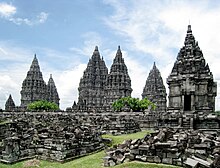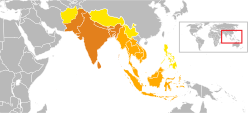বৃহত্তর ভারত
বৃহত্তর ভারত যাকে ভারতীয় সাংস্কৃতিক ক্ষেত্রও বলা হয়, দক্ষিণ এশিয়া, পূর্ব এশিয়া এবং দক্ষিণ-পূর্ব এশিয়ার কিছু দেশ ও অঞ্চল নিয়ে গঠিত। এসব দেশ এক সময় ভারতীয় সংস্কৃতির প্রভাবের মধ্যে ছিল, যা দক্ষিণ এশিয়ার স্থানীয় সংস্কৃতি থেকে তৈরি হয়েছিল।[১] এই ধারণা ভারতীয় উপমহাদেশ এবং আশপাশের দেশগুলোকে অন্তর্ভুক্ত করে, যেগুলো একে অপরের সংস্কৃতি ও প্রথা গ্রহণের মাধ্যমে পরিবর্তিত হয়েছে। "বৃহত্তম ভারত" শব্দটি ১৯২০-এর দশকে বাঙালি পণ্ডিতরা জনপ্রিয় করেছিলেন, তবে ১৯৭০-এর পর এটি আর তেমন ব্যবহার হয় না।
প্রায় ৫০০ খ্রিস্টপূর্বাব্দ থেকে এশিয়ার ভূমি ও সমুদ্রপথে বাণিজ্যের বিস্তার দীর্ঘমেয়াদি সামাজিক, অর্থনৈতিক ও সাংস্কৃতিক পরিবর্তন ঘটিয়েছিল। এর ফলে বিশেষ করে দক্ষিণ-পূর্ব এশিয়া এবং শ্রীলঙ্কার সংস্কৃতিতে বৌদ্ধ ও হিন্দু বিশ্বাসের প্রভাব পড়ে।[২] মধ্য এশিয়ায় এই ধারণাগুলোর প্রচার মূলত ধর্মীয় বিষয়ের উপর ভিত্তি করে ছিল।
খ্রিস্টীয় প্রথম দিকের শতকগুলোতে দক্ষিণ-পূর্ব এশিয়ার অধিকাংশ রাজ্য ভারতীয় সংস্কৃতি, ধর্ম এবং প্রশাসনের মূল বৈশিষ্ট্যগুলোকে নিজেদের মধ্যে গ্রহণ করেছিল। হরিহরার ধারণার মাধ্যমে দেব-রাজত্বের ধারণা প্রচলিত হয়। সংস্কৃত এবং দক্ষিণ ভারতের পল্লব ও চালুক্য রাজবংশের মতো ভারতীয় লিপি ব্যবস্থা সরকারি ভাষা হিসেবে স্বীকৃত হয়।[৩][৪] এই ভারতীয়কৃত রাজ্যগুলো, যা জর্জ কোডেস তার বই ইস্তোয়ার আনসিয়েন দে এতা অঁদুইজে দে'এক্সত্রেম-অরিঁ-এ উল্লেখ করেছেন,[৫] তারা স্থিতিশীলতা, রাজনৈতিক ঐক্য এবং প্রশাসনিক দক্ষতার জন্য পরিচিত ছিল।[৬]
উত্তরের দিকে, ভারতীয় ধর্মীয় ধারণাগুলো হিমালয়ের জনগণের সংস্কৃতিতে মিশে গিয়েছিল, বিশেষ করে তিব্বত ও ভুটানে এবং সেখানকার স্থানীয় ঐতিহ্যের সাথে একীভূত হয়। বৌওজদ্ধ ভিক্ষুপ্রথা আফগানিস্তান, উজবেকিস্তান এবং মধ্য এশিয়ার অন্যান্য অঞ্চলে ছড়িয়ে পড়ে। বৌদ্ধ গ্রন্থ ও ধারণাগুলো পূর্বে চীন এবং জাপানে গ্রহণ করা হয়। পশ্চিমে, হিন্দুকুশ ও পামির পর্বতমালার মাধ্যমে ভারতীয় সংস্কৃতি গ্রেটার পারস্যের সঙ্গে মিলিত হয়।[৭]
অন্যান্য ব্যবহার
[সম্পাদনা]
ইউরোপীয় প্রশিক্ষণে
[সম্পাদনা]তিন ভারতের ধারণা প্রাক-শিল্প ইউরোপে বহুপ্রচলিত ছিল। বৃহত্তর ভারত দক্ষিণ এশিয়ার দক্ষিণ অংশকে, ক্ষুদ্রতর ভারত দক্ষিণ এশিয়ার উত্তর অংশকে এবং মধ্য ভারত মধ্যপ্রাচ্যের কাছাকাছি অঞ্চলকে বলা হত।[৮] পর্তুগীজ ফর্ম (পর্তুগিজ: India Maior[৮][৯][১০][১১]) অন্তত মধ্য-১৫দশ শতাব্দী থেকে ব্যবহৃত হয়।[৯] এই পদটি, যা পরিবর্তনশীল স্পষ্টতার সঙ্গে ব্যবহার করা হত বলে মনে হয়,[১২] কখনও কখনও শুধুমাত্র ভারতীয় উপমহাদেশকে বোঝাত।[১৩] ইউরোপীয়রা দক্ষিণ এশিয়ার উপদ্বীপ বোঝাতে দক্ষিণ এশিয়ার সাথে সম্পর্কিত বিভিন্ন পদ ব্যবহার করত, যেমন উচ্চ ভারত, বৃহত্তর ভারত, বহিঃভারত, ভারত aquosa। [১৪]
তবে ইউরোপীয় নৌযাত্রার কিছু বিবরণে, বৃহত্তর ভারত (বা India Major) মালাবার কোস্ট (অধুনাতন কেরল) থেকে India extra Gangem[১৫] পর্যন্ত বিস্তৃত ছিল (সাহিত্যে "গঙ্গা-পরবর্তী ভারত" কিন্তু সাধারণত পূর্ব ইন্ডিজ, অর্থাৎ অধুনাতন মালয় দ্বীপপুঞ্জ) এবং ক্ষুদ্রতর ভারত, মালাবার থেকে সিন্ধু পর্যন্ত বিস্তৃত ছিল।[১৬] অধিকতর ভারত কখনো আধুনিক দক্ষিণ-পূর্ব এশিয়াকে আবার কখনো শুধুমাত্র মূলভূখন্ডের অংশকে বোঝাতে ব্যবহৃত হত।[১৪] ১৪দশ শতাব্দী পর্যন্ত, ভারত বলতে সোমালিয়া, দক্ষিণ আরব ও ইথিওপিয়া সহ লোহিত সাগর বরাবর এলাকা বোঝাতেও ব্যবহৃত হত (যেমন, খ্রিস্টপূর্ব প্রথম শতাব্দীর সিসিলিবাসী ডিওডোরাস বলেন যে, "নীল নদের সৃষ্টি ভারতে" এবং চতুর্দশ শতাব্দীর মার্কো পোলো বলছেন যে "ক্ষুদ্রতর ভারতে ... রয়েছে ... আবাষ [আবিসিনিয়া]")।[১৭]
১৯শ শতাব্দীর শেষদিকের ভূগোলে বৃহত্তর ভারত বলতে পাঞ্জাব, হিমালয় সমেত ব্রিটিশ ভারত, হিন্দুস্তান (উত্তর-পশ্চিম উপমহাদেশ) বোঝাত এবং পূর্বদিকে ইন্দোচীন (বার্মা সহ), ইন্দোনেশিয়ার অংশবিশেষে (যথা, সুন্দা দ্বীপপুঞ্জ, বোর্নিও এবং Celebes) এবং ফিলিপাইন অবধি বিস্তৃত ছিল।[১৮] জার্মান atlases Vorder-Indien (পূর্ববর্তী ভারত) দক্ষিণ এশিয়ার উপদ্বীপকে এবং Hinter-Indien দক্ষিণ-পূর্ব এশিয়াকে বলত।[১৪]
ভূতত্ত্বে
[সম্পাদনা]- বৃহত্তর ভারত বেসিন তত্ত্ব
বৃহত্তর ভারত, বা বৃহত্তর ভারত বেসিন "ভারতীয় প্লেট এবং একটি বংশগৌরবের উত্তরীয় এক্সটেনশন" বোঝায় যা ভারত-এশিয়া সংঘর্ষের গুণফল।[১৯] যদিও ভূতত্ত্বে এর ব্যবহার প্লেট টেকটনিক তত্ত্বে হয়,[২০] পদটির বর্ধিত ব্যবহার ১৯৭০ সালের আগে হয়নি।
এই তত্ত্বটি যতদিন ভারত-এশিয়া অভিসৃতির অবস্থান ও সময় বিতর্ক বিদ্যমান ছিল ততদিন বৈধ আছে। কীভাবে এবং কোথায় ভারত-এশিয়া (ভারত ও ইউরেশীয় প্লেট) অভিসৃতি হয়, সংঘর্ষের পর, ৫.২ কোটি বছর আগে? যেহেতু প্লেটগুলি ৩,৬০০ কিমি (২,২00 মাইল) ± 35 কিমি (২২ মাইল)পর্যন্ত মিশে আছে, এশিয়ার ভূতাত্ত্বিক রেকর্ড থেকে সংগ্রহ অনুসারে উপরের ভূত্বক প্রায় ২,৩৫০ কিমি (১,৪৬০ মাইল) কম।[২১]
জাতীয়তাবাদী আন্দোলনে
[সম্পাদনা]- গ্রেটার ইন্ডিয়া সোসাইটি
বাংলা পণ্ডিতদের একটি সংগঠন, যারা সকলে কলকাতা-ভিত্তিক গ্রেটার ইন্ডিয়া সোসাইটি র সদস্য ছিল, বৃহত্তর ভারত পদের ব্যবহার জনপ্রিয় করেন। এই আন্দোলনের প্রথম দিকে নেতাদের মধ্যে আছেন ইতিহাসবিদ আর সি মজুমদার (১৮৮৮-১৮৯০); ভাষাতত্ত্ববিদ সুনীতিকুমার চট্টোপাধ্যায় (১৮৯০-১৯৭৭) ও পি সি বাগচী (১৮৯৮-১৯৫৬) এবং ঐতিহাসিক ফনীন্দ্রনাথ বসু ও কালিদাস নাগ (১৮৯১-১৯৬৬)।[২২]
বৃহত্তর ভারত পদ ও প্রাচীন দক্ষিণ-পূর্ব এশিয়ার স্পষ্ট হিন্দু ঔপনিবেশিকতার ধারণা -- উভয়ই ভারতীয় জাতীয়তাবাদের[২৩] এবং হিন্দু জাতীয়তাবাদের[২৪] সঙ্গে সম্পর্কিত।
আরও দেখুন
[সম্পাদনা]তথ্যসূত্র
[সম্পাদনা]- ↑ Lévi, Sylvain; Przyluski, Jean; Bloch, Jules (১৯৯৩)। Pre-Aryan and Pre-Dravidian in India। Asian Educational Services। আইএসবিএন 978-81-206-0772-9। ২৬ মার্চ ২০২৩ তারিখে মূল থেকে আর্কাইভ করা। সংগ্রহের তারিখ ২৬ মার্চ ২০২৩।
- ↑ Kenneth R. Hal (১৯৮৫)। Maritime Trade and State Development in Early Southeast Asia। University of Hawaii Press। পৃষ্ঠা 63। আইএসবিএন 978-0-8248-0843-3। ২৬ মার্চ ২০২৩ তারিখে মূল থেকে আর্কাইভ করা। সংগ্রহের তারিখ ২৬ মার্চ ২০২৩।
- ↑ Lavy, Paul (২০০৩), "As in Heaven, So on Earth: The Politics of Visnu Siva and Harihara Images in Preangkorian Khmer Civilisation", Journal of Southeast Asian Studies, 34 (1): 21–39, এসটুসিআইডি 154819912, ডিওআই:10.1017/S002246340300002X, ১২ আগস্ট ২০২১ তারিখে মূল থেকে আর্কাইভ করা, সংগ্রহের তারিখ ২৩ ডিসেম্বর ২০১৫
- ↑ Stark, Miriam T.; Griffin, Bion; Phoeurn, Chuch; Ledgerwood, Judy; ও অন্যান্য (১৯৯৯)। "Results of the 1995–1996 Archaeological Field Investigations at Angkor Borei, Cambodia" (পিডিএফ)। Asian Perspectives। University of Hawai'i-Manoa। 38 (1)। ২৩ সেপ্টেম্বর ২০১৫ তারিখে মূল (পিডিএফ) থেকে আর্কাইভ করা। সংগ্রহের তারিখ ৫ জুলাই ২০১৫।
The development of maritime commerce and Hindu influence stimulated early state formation in polities along the coasts of mainland Southeast Asia, where passive indigenous populations embraced notions of statecraft and ideology introduced by outsiders...
- ↑ Coedès (1968), pp. 14–.
- ↑ Manguin, Pierre-Yves (২০০২), "From Funan to Sriwijaya: Cultural continuities and discontinuities in the Early Historical maritime states of Southeast Asia", 25 tahun kerjasama Pusat Penelitian Arkeologi dan Ecole française d'Extrême-Orient, Jakarta: Pusat Penelitian Arkeologi / EFEO, পৃষ্ঠা 59–82, ২৬ মার্চ ২০২৩ তারিখে মূল থেকে আর্কাইভ করা, সংগ্রহের তারিখ ২৬ মার্চ ২০২৩
- ↑ Zhu, Qingzhi (মার্চ ১৯৯৫)। "Some Linguistic Evidence for Early Cultural Exchange between China and India" (পিডিএফ)। Sino-Platonic Papers। University of Pennsylvania। 66। ৪ আগস্ট ২০১৯ তারিখে মূল (পিডিএফ) থেকে আর্কাইভ করা। সংগ্রহের তারিখ ২৬ মার্চ ২০২৩।
everyone knows well the so-called "Buddhist conquest of China" or "Indianized China"
- ↑ ক খ Phillips, J. R. S. (১৯৯৮)। The Medieval Expansion of Europe। Clarendon Press। পৃষ্ঠা 192। আইএসবিএন 978-0-19-820740-5।
- ↑ ক খ (Azurara 1446)
- ↑ Lewis, Martin W.; Wigen, Kären (১৯৯৭)। The Myth of Continents: A Critique of Metageography। University of California Press। পৃষ্ঠা 269। আইএসবিএন 978-0-520-20742-4।
- ↑ Pedro Machado, José (১৯৯২)। "Terras de Além: no Relato da Viagem de Vasco da Gama"। Journal of the University of Coimbra। 37: 333–।
- ↑ (Beazley 1910, পৃ. 708) Quote: "Azurara's hyperbole, indeed, which celebrates the Navigator Prince as joining Orient and Occident by continual voyaging, as transporting to the extremities of the East the creations of Western industry, does not scruple to picture the people of the Greater and the Lesser India"
- ↑ (Beazley 1910, পৃ. 708) Quote: "Among all the confusion of the various Indies in Mediaeval nomenclature, "Greater India" can usually be recognized as restricted to the "India proper" of the modern world."
- ↑ ক খ গ Lewis, Martin W.; Wigen, Kären (১৯৯৭)। The Myth of Continents: A Critique of Metageography। University of California Press। পৃষ্ঠা 274। আইএসবিএন 978-0-520-20742-4।
- ↑ (Wheatley 1982, পৃ. 13) Quote: "Subsequently the whole area came to be identified with one of the "Three Indies," though whether India Major or Minor, Greater or Lesser, Superior or Inferior, seems often to have been a personal preference of the author concerned. When Europeans began to penetrate into Southeast Asia in earnest, they continued this tradition, attaching to various of the constituent territories such labels as Further India or Hinterindien, the East Indies, the Indian Archipelago, Insulinde, and, in acknowledgment of the presence of a competing culture, Indochina."
- ↑ (Caverhill 1767)
- ↑ Uhlig, Siegbert (২০০৩)। Encyclopaedia Aethiopica: He-N। Isd। পৃষ্ঠা 145। আইএসবিএন 978-3-447-05607-6।
- ↑ "Review: New Maps," (1912) Bulletin of the American Geographical Society 44(3): 235–240.
- ↑ (Ali ও Aitchison 2005, পৃ. 170)
- ↑ Argand, E., 1924. La tectonique de l' Asie. Proc. 13th Int. Geol. Cong. 7 (1924), 171–372.
- ↑ "The Greater India Basin hypothesis" (পিডিএফ)। University of Oslo। সংগ্রহের তারিখ ডিসেম্বর ২০, ২০১৬।
- ↑ (Bayley 2004, পৃ. 710)
- ↑ (Keenleyside 1982, পৃ. 213–214) Quote: "Starting in the 1920s under the leadership of Kalidas Nag-and continuing even after independence-a number of Indian scholars wrote extensively and rapturously about the ancient Hindu cultural expansion into and colonisation of South and Southeast Asia. They called this vast region "Greater India"–a dubious appellation for a region which to a limited degree, but with little permanence, had been influenced by Indian religion, art, architecture, literature and administrative customs. Indeed, Congress leaders made occasional references to Greater India while the organisation's abiding interest in the problems of overseas Indians lent indirect support to the Indian hope of restoring the alleged cultural and spiritual unity of South and Southeast Asia."
- ↑ (Thapar 1968, পৃ. 326–330) Quote: "At another level, it was believed that the dynamics of many Asian cultures, particularly those of Southeast Asia, arose from Hindu culture, and the theory of Greater India derived sustenance from Pan-Hinduism. A curious pride was taken in the supposed imperialist past of India, as expressed in sentiments such as these: "The art of Java and Kambuja was no doubt derived from India and fostered by the Indian rulers of these colonies." (Majumdar, R. C. et al. (1950), An Advanced History of India, London: Macmillan, p. 221) "
আরোও পড়ুন
[সম্পাদনা]- Language variation: Papers on variation and change in the Sinosphere and in the Indosphere in honour of James A. Matisoff, David Bradley, Randy J. LaPolla and Boyd Michailovsky eds., pp. 113–144. Canberra: Pacific Linguistics.
- Bijan Raj Chatterjee (১৯৬৪)। Indian Cultural Influence in Cambodia। University of Calcutta।
- Ankerl, Guy (২০০০)। Global communication without universal civilisation। INU societal research। Vol.1: Coexisting contemporary civilisations : Arabo-Muslim, Bharati, Chinese, and Western। Geneva: INU Press। আইএসবিএন 2-88155-004-5।
বহিঃসংযোগ
[সম্পাদনা]- Rethinking Tibeto-Burman – Lessons from Indosphere
- THEORIES OF INDIANISATION Exemplified by Selected Case Studies from Indonesia (Insular Southeast Asia), by Dr. Helmut Lukas
